Transcription of Public Assessment Report - GOV.UK
1 Public Assessment Report Decentralised Procedure zopiclone and Film-coated Tablets Procedure No: UK/H/2575/001-2/DC UK Licence No: PL 17907/0122 and PL 17907/0051 Bristol Laboratories Limited zopiclone and Film-coated Tablets UK/H/2575/001-2/DC 2 LAY SUMMARY On 23 June 2011, the Medicines and Healthcare products Regulatory Agency (MHRA) granted Marketing Authorisations to Bristol Laboratories Limited for medicines called zopiclone and Film-coated Tablets (PL 17907/0122 and 0051; UK/H/2575/001-2/DC). These medicines are available on prescription from your doctor. zopiclone and Film-coated Tablets induce sleep and are used in the short-term treatment of sleeplessness. The active ingredient, zopiclone , is a sedative-hypnotic (sleeping pill), which belongs to a class of medicines called cyclopyrrolones.
2 zopiclone has properties similar to that of the benzodiazepines. You should use benzodiazepines or benzodiazepine-like substances only if you suffer from severe sleep disorders which cause you extreme distress. No new or unexpected safety concerns arose from these applications and it was, therefore, judged that the benefits of taking zopiclone and Film-coated Tablets outweigh the risks, and Marketing Authorisations were granted. zopiclone and Film-coated Tablets UK/H/2575/001-2/DC 3 TABLE OF CONTENTS Module 1: Information about initial procedure Page 4 Module 2: Summary of Product Characteristics Page 5 Module 3: Product Information Leaflet Page 19 Module 4: Labelling Page 21 Module 5.
3 Scientific Discussion Page 23 I Introduction II About the product III Scientific Overview and Discussion III 1 Quality aspects III 2 Non-clinical aspects III 3 Clinical aspects IV Overall Conclusion and Benefit/risk Assessment Module 6 Steps taken after initial procedure zopiclone and Film-coated Tablets UK/H/2575/001-2/DC 4 Module 1 Information about the initial procedure Product Names zopiclone Film-coated Tablets zopiclone Film-coated Tablets Type of Application Generic, Article Active Substance zopiclone Form Film-coated tablets Strength and MA Holder Bristol Laboratories Ltd. Unit 3, Canalside, Northbridge Road Berkhamsted Herts, HP14 1EG UK Reference Member State (RMS) UK Concerned Member States (CMS) Czech Republic, Germany, Hungary and Slovak Republic Procedure Number UK/H/2575/001-2/DC Timetable Day 210 18 May 2011 zopiclone and Film-coated Tablets UK/H/2575/001-2/DC 5 Module 2 1 NAME OF THE MEDICINAL PRODUCT zopiclone Film-coated Tablets.
4 2 QUALITATIVE AND QUANTITATIVE COMPOSITION Each film-coated tablet contains mg zopiclone Excipient: Each film-coated tablet contains mg lactose. For a full list of excipients, see section 3 PHARMACEUTICAL FORM Film-Coated Tablets (Tablets) Blue coloured, round, biconvex film coated tablets plain on both sides. 4 CLINICAL PARTICULARS Therapeutic indications Short-term treatment of insomnia. Benzodiazepines and benzodiazepine-like substances are only indicated when the disorder is severe, disabling or subjecting the individual to extreme distress. Posology and method of administration Treatment with zopiclone should be for as short a period as possible. The period of treatment should generally vary between a few days to 2 weeks, with a maximum of 4 weeks including the tapering off phase.
5 In certain cases it may be necessary to prolong treatment to beyond the maximum period. If this is the case, however, it should only take place after re-evaluation of the patient s condition. The recommended dose for adults is mg (two tablets). This dose should not be exceeded. The product should be taken immediately before going to bed. In the elderly, patients with hepatic insufficiency or chronic respiratory insufficiency, treatment should be started at a dosage of mg. Although no accumulation of zopiclone or its metabolites have been found in patients with renal insufficiency, it is advisable to begin treatment of patients with reduced renal function at mg. Paediatric patients zopiclone is contraindicated in children and adolescents under 18 (see section ). Contraindications zopiclone is contra-indicated in the following cases: Hypersensitivity to the active substance or to any of the excipients Myasthenia gravis Severe respiratory insufficiency Sleep apnoea syndrome Children and adolescents under 18 years of age Severe hepatic insufficiency Special warnings and precautions for use Before starting treatment with zopiclone any underlying cause of insomnia should be addressed carefully.
6 Dependence The use of benzodiazepines and benzodiazepine-like substances can lead to physical and psychological dependence on these agents. The risk of dependence increases the higher the dose and the longer the period of treatment; the risk of dependence is also greater in patient with a history of alcohol or drug zopiclone and Film-coated Tablets UK/H/2575/001-2/DC 6 abuse or those who have marked personality disorders. If physical dependence occurs, sudden discontinuation of the treatment will be accompanied by withdrawal symptoms. These may be expressed as headaches, muscle pain, extreme anxiety, tension, restlessness, confusion and irritability. In severe cases the following symptoms may occur: derealisation, depersonalisation, hyperacusis, numbness and tingling of the extremities, hypersensitivity to light, noise or physical contact, hallucinations or epileptic seizures.
7 Rare cases of abuse have been reported. Rebound insomnia After discontinuation of treatment with a benzodiazepine or a benzodiazepine-like substance, a temporary syndrome may occur in which the symptoms which led to the treatment with the benzodiazepine or a benzodiazepine-like substance return in a more severe form. This syndrome may be accompanied by other reactions, including mood changes, anxiety and restlessness. Since the risk of withdrawal symptoms or rebound symptoms is greater after abrupt interruption of the treatment it is advisable to reduce the dosage gradually. Period of treatment The period of treatment should be as short as possible (see Posology and method of administration) but not longer than 4 weeks including the tapering off process. This period should only be exceeded after re-evaluation of the patient s condition.
8 It may be of benefit to inform the patient at the beginning of treatment that the treatment will be of short duration, and to explain precisely how to reduce the dose gradually. It is also important to point out to the patient the possibility of the occurrence of rebound phenomena in order to keep to a minimum any worries about the occurrence of such symptoms during the tapering off period of the treatment. In the case of benzodiazepines and benzodiazepine-like substances with a short period of action, there are indications that withdrawal symptoms may occur within the dosage interval, especially if the dose is high. Tolerance The hypnotic effect of short-acting benzodiazepines and benzodiazepine-like substances may diminish after repeated use for a few weeks. For zopiclone however, no pronounced tolerance has occurred during a treatment period of up to 4 weeks.
9 Anterograde amnesia Benzodiazepines and benzodiazepine-like substances may cause anterograde amnesia, in particular a few hours after taking the product. In order to reduce the risk patients should ensure that they will be able to have an uninterruped sleep of 7-8 hours (see section Undesirable effects). Psychiatric and paradoxical reactions It is known that reactions such as restlessness, agitation, irritability, aggression, delusions, outbursts of rage, nightmares, hallucination, psychoses, unsuitable behaviour and other behavioural disturbances may occur during the use of benzodiazepines and benzodiazepine-like substances. If this is the case administration of the medicinal product should be discontinued. The risk of these reactions is greater in children and the elderly. Somnambulism and associated behaviours Sleep walking and other associated behaviours such as sleep driving , preparing and eating food, or making phone calls, with amnesia for the event, have been reported in patients who have taken zopiclone and were not fully awake.
10 The use of alcohol and other CNS-depressants with zopiclone appears to increase the risk of such behaviours, as does the use of zopiclone at doses exceeding the maximum recommended dose. Discontinuation of zopiclone should be strongly considered for patients who Report such behaviours (see section ). Specific patient groups For the elderly: see Posology and method of administration. A lower dose is advised for patients with chronic respiratory insufficiency due to the risk of respiratory depression. Benzodiazepines and benzodiazepine-like substances are not suitable for the treatment of patients with severe hepatic insufficiency, since they may promote the occurrence of encephalopathy. Benzodiazepines and benzodiazepine-like substances are not recommended as the primary treatment of psychoses. Benzodiazepines and benzodiazepine-like substances should not be used as the sole treatment of depression or anxiety linked with depression (suicide may be triggered in such patients).


















